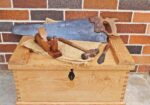When it comes to high-end woodworking projects like constructing a timber-frame home, assembling a trestle table, or crafting a step stool, the most effective method for keeping everything intact is by utilizing both glue and hand-cut joints.
In this text, we will break down how the edge joint and the mortise and tenon joints function. By using these joints, you can construct various furniture items and undertake woodworking projects without needing to depend on nails and screws, which although time-saving, can be unattractive.
First Step: Edge Joints
In order for an edge joint to be considered good, the two surfaces that are being joined must fit together without any visible gaps. Additionally, these surfaces must be located on the edge of a board rather than on the surface. The reason for this is that end grain, which has an open cellular structure, is not suitable for edge joining. When glue is applied to the end grain, it is absorbed deep into the wood, making it difficult for the bond to occur on the surface. When it is necessary to join end grain with either edge or face grain, the preferred joint is the mortise and tenon.
In order to perform edge joining, it is essential for the surfaces that will be joined to be flat and square to both faces of the board. To accomplish this, start by marking a straight reference line on one of the surfaces using a long straightedge. Afterward, securely attach this board to the side of your worktable and utilize a bench plane to level the edge. Regularly assess your progress by comparing it to the reference line. Additionally, frequently check for squareness with a combination square.
After achieving the desired smoothness on the first board’s edge, proceed with the same process on the second board. Once you have flattened this edge as well, place the two boards on a flat surface together and assess the fit. Typically, further adjustments will be necessary to achieve a flawless joint. Once you have attained the desired fit, simply apply glue to both mating edges.
Proceed to secure or fasten tightly using a clamp.
Hold the boards tightly in place until the adhesive dries properly.
Step 3: The process of doweling.
When edge joining boards, a common issue is that the glue can function as a lubricant, resulting in slippage and a ruined flat joint. To address this problem, there are three typical solutions: dowels, joining plates, and splines. For beginners, using dowels is recommended as it only requires a drill and a doweling jig.
For standard 13/16-in.-thick stock, it is recommended to use 1/4-in.-dia. x 1-in.-long dowels. Begin by marking the dowel locations every 6 in. to 8 in. along the joint. Next, insert the 1/4-in.-dia. bushing into the doweling jig and position the jig’s hole directly over the first mark. Secure the jig in place and drill a hole in the edge. Ensure that the hole is deep enough to leave a 1/16 inch. gap at each end of the dowel for excess glue. Repeat this process for each hole along the joint.
Birch dowel stock can be found in hardware stores and lumberyards in 36-inch lengths and diameters ranging from 1/8 inch to 1 inch. To ensure proper usage of this material, it is recommended to create a narrow groove along the length of each piece to allow excess glue to escape. One way to achieve this is by using the corner of a sharp chisel to scratch the side of the dowel. Additionally, both ends of the dowel should be slightly beveled using sandpaper. This bevel will facilitate the alignment of the dowels in their respective mating holes.
Proceed to tap the dowels.
After cutting your dowels to the desired size, apply a thin layer of glue on all the holes where the dowels will go and on the edges of the boards that will be joined. Next, carefully insert the dowels into the holes.
Step 5: Establish a joint venture.
Step-by-step, align the mating board in such a way that the exposed dowels meet their respective holes. Utilize clamps to firmly secure the joint together. Gradually tighten the clamps to allow any surplus glue to flow out, and keep the joint clamped until the glue sets.
Step number six involves the process of creating a mortise and tenon, while ensuring that no additional information is added or removed.
When joining the end grain to the long grain, the mortise-and-tenon joint is considered the most effective method. The tenon, which is a male component, is crafted on one board’s end and is specifically designed to fit into a slot of the same size called the mortise on the corresponding board.
To start positioning the joint, first, make a mark indicating the length of the finished tenon, which typically ranges from 1 inch to 1 1/2 inches. Utilize a square and pencil to continue this marking onto the sides and edges of the board.
Step 7: Establish guides
To prepare your marking gauge, adjust it to make a mark at the center of the board end indicating the width of the tenon. When working with stock that is 13/16 inch thick, the usual thickness for the tenon is 3/8 inch, with 7/32 inch shoulders on both sides. However, it is also acceptable to have a tenon that is 5/16 inch thick, with shoulders that are 1/4 inch thick. Use the marking gauge to draw these guidelines across the end grain and down the two edges until they intersect with the shoulder line.
Step 8: Utilize a saw to create a joint by cutting through the desired material.
To start, secure the board firmly with the joint end facing upwards. Utilize a backsaw to carefully cut along the marked lines. Ensure that your saw’s groove consistently stays on the side where material will be discarded, and cease cutting once you reach the designated stopping point.
Step 9: Trim Excess Edge
First, secure the board firmly onto your worktable and proceed to use a backsaw to make a cut along the shoulder line, on the side opposite to the desired outcome. Once this cut has been accomplished, the excess material should detach from the tenon’s side. Proceed to repeat this identical procedure on the opposing side of the joint.
Step 10: Carve the tenon using a chisel.
Afterwards, use a sharp chisel to reduce the sides of the tenon (also known as the cheeks) to match the guide lines.
Step 11: Slice the upper and lower parts.
To cut these, the first step is to lay out the guide lines using a marking gauge, as most tenons also have shoulder cuts on the top and bottom edges.
Step 12: Reduce the size of the tenon by cutting it shorter.
Begin by cutting along the length of the tenon using a backsaw, and then proceed by cutting along the shoulder line on both edges. After completing these steps, set the tenons aside temporarily and focus on working on the mortises.
The thirteenth step involves completing the mortise.
To mark guide lines for the mortise in the mating board, utilize the marking gauge and square. The necessary tools for accurately removing a significant amount of stock when cutting the mortise are a drill and doweling jig.
Step 14: Drilling Holes.
To rephrase the text: 1. Begin by inserting a bushing in the doweling jig that corresponds to the width of your mortise. 2. Proceed to clamp the jig onto the board, ensuring that the hole is positioned centrally between your layout lines. 3. Slide the drill bit into the bushing and commence boring a series of overlapping holes until all the waste material has been removed.
Step 15 involves testing the joint by fitting square ends together.
To achieve optimal outcomes, you can follow these steps: 1. Attach the collar from the jig to the drill bit to set the desired hole depth. 2. The depth of the hole should be 1/16 inch greater than the length of the tenon. 3. This additional depth allows room for any surplus glue, which could prevent the joint from fully closing. 4. After completing the drilling process for all the holes, utilize a chisel to square the ends and sides of the mortise.
After completing all the previous steps, make sure to test the fit of the joint. The tenon should fit tightly in the mortise, but it shouldn’t require excessive force to put the parts together. In case the joint is too tight, carefully trim the sides of the tenon using a sharp chisel until it fits properly. For small adjustments, sandpaper can be used. Once you are happy with the fit, apply glue to all the surfaces that will be in contact and slide the pieces together. Use clamps to securely hold the pieces together until the glue is fully dried.
Types of Wood Joints
Wood joinery is a fundamental concept in woodworking. Without the capability to securely join two pieces of wood, all woodworking pieces would be sculptures made from a single piece of wood. Nevertheless, there are various types of wood joinery available, providing woodworkers with a range of joints to choose from for different projects. By mastering these wood joinery concepts, one can greatly advance as a skillful woodworker.
The basic butt joint is a type of joint that is simple to create and commonly used in woodworking projects.
The butt joint is the simplest form of wood joinery. It involves one piece of wood being placed directly against another piece (typically at a right angle) and secured with mechanical fasteners. This joint is commonly used in construction for wall framing purposes.
The Mitered Butt Joint follows a sequential approach.
The mitered butt joint is similar to the basic butt joint, but with the boards joined at an angle instead of being square to each other. The benefit is that the mitered butt joint avoids displaying any end grain, which makes it more visually appealing. However, the mitered butt joint lacks strength.
A joint known as the half-lap joint.
The half-lap joint involves removing half of each of the two boards to create a flush connection. Although this type of wood joinery weakens the adjacent boards, it is stronger than butt joints. Despite its drawbacks, there are several projects where this wood joint is highly desirable.
The tongue and groove joint is a method of joining two pieces of wood by interlocking a protruding tongue on one piece into a receiving groove in the other piece.
If you want to connect two boards that are perpendicular to each other along a long edge, you can easily align the joint and secure it with fasteners. Nonetheless, the tongue and groove joint offers increased durability and a larger surface area, making it especially advantageous when intending to use adhesive for the joint.
The joint known as Mortise and Tenon
The mortise and tenon is a traditional wood joinery technique that has been used in woodworking since ancient times. It remains one of the strongest and most graceful methods for connecting wood.
A biscuit joint is a method used in woodworking to join two pieces of wood together.
A different technique for connecting boards along the edges, similar to the tongue and groove joint, involves cutting slots and utilizing beechwood wafers, also known as biscuits, to secure the boards together. This contemporary woodworking joint is highly beneficial, especially for constructing table tops, as it relies on adhesive and the expansion of the beechwood biscuit to firmly hold the boards in position.
Joint pocket.
The pocket joint, used in wood joinery, requires cutting a slot and pre-drilling a pilot hole at an angle between two boards prior to connecting the boards with a screw. This pre-drilling task requires precision and is commonly done using a commercial jig. Pocket joints are ideal for cabinet face frames and other similar applications that do not require excessive strength.
Rephrase according to the given instructions: Dado, please think systematically and provide a revised version of the text below while ensuring that the meaning remains unchanged. You should refrain from adding new information or omitting any existing information.
A dado is simply a square-grooved slot on one board that is designed to accommodate another board. This type of wood joint, akin to tongue and groove joinery, is widely utilized in connecting plywood, particularly in the construction of cabinetry.
Rabbet is an action that involves thinking step by step.
The rabbet, another frequently used wood joint in cabinetry, is essentially a dado cut made along the edge of a board. It is commonly utilized at the rear of cabinets and similar assemblies in order to attach the back to the sides of the box, resulting in a significant increase in strength for the overall assembly.
By utilizing Dovetail Joint, one can approach the task by thinking step by step to rephrase the given text, while ensuring that the meaning remains intact. No additional information should be included, and no information should be omitted.
When considering all methods of wood joinery, the through dovetail is widely respected. It is renowned for its elegance and durability, enhancing the sophistication of any item. Various approaches exist for crafting through dovetails, ranging from manual cutting to utilizing a jig for machine-based shaping.






